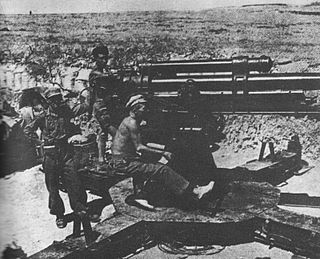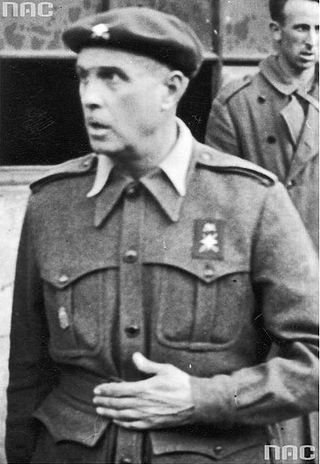
The Battle of the Ebro was the longest and largest battle of the Spanish Civil War and the greatest, in terms of manpower, logistics and material ever fought on Spanish soil. It took place between July and November 1938, with fighting mainly concentrated in two areas on the lower course of the Ebro River, the Terra Alta comarca of Catalonia, and the Auts area close to Fayón (Faió) in the lower Matarranya, Eastern Lower Aragon. These sparsely populated areas saw the largest array of armies in the war. The battle was disastrous for the Second Spanish Republic, with tens of thousands left dead or wounded and little effect on the advance of the Nationalists.

The Battle of Brunete, fought 24 kilometres (15 mi) west of Madrid, was a Republican attempt to alleviate the pressure exerted by the Nationalists on the capital and on the north during the Spanish Civil War. Although initially successful, the Republicans were forced to retreat from Brunete after Nationalist counterattacks, and suffered devastating casualties from the battle.
The Second Battle of the Corunna Road was a battle of the Spanish Civil War that took place from 13 December 1936 to 15 January 1937, northwest of Madrid. In December 1936, the Nationalists launched an offensive in order to cut the Corunna Road and isolate Madrid, but a Republican counter-offensive stopped the Nationalist advance. The Nationalists cut the Corunna road but failed to encircle Madrid.

The War in the North was a theatre of the Spanish Civil War that occurred in northern Spain from 31 March to 21 October 1937.

José Solchaga Zala was a Spanish general who fought for the Nationalists in the Spanish Civil War.

The XII International Brigade was mustered on 7 November 1936 at Albacete, Spain. It was formerly named the Garibaldi Brigade, after the most famous and inspiring leader in the Italian Independence Wars, General Giuseppe Garibaldi.
Gustavo Durán Martínez (1906–1969) was a Spanish composer, Lieutenant Colonel in the Spanish military, diplomat and United Nations official.

The Biscay Campaign was an offensive of the Spanish Civil War which lasted from 31 March to 1 July 1937. 50,000 men of the Eusko Gudarostea met 65,000 men of the insurgent forces. After heavy combats the Nationalist forces with a crushing material superiority managed to occupy the city of Bilbao and the Biscay province.

The Asturias Offensive was an offensive in Asturias during the Spanish Civil War from 1 September to 21 October 1937.
The siege of Santuario de Nuestra Señora de la Cabeza took place from 14 September 1936 to 1 May 1937 in Andújar, Jaén, during the Spanish Civil War. The Republican army surrounded around 1,200 rebel civil guards and falangists who supported the Nationalists and forced them to surrender after a protracted offensive.

The Battle of Seseña was a Republican-Soviet assault on the Nationalist stronghold of Seseña, near Toledo, 30 km south of Madrid in October 1936 during the Spanish Civil War. After the fall of Talavera de la Reina and Toledo in September 1936, the Nationalist troops pushed towards Madrid and in October they were 30 km from the city. The Republican government which had received new Soviet weapons decided to launch a counteroffensive in order to stop the Nationalist offensive at Seseña. The attack failed and the Nationalists resumed their advance towards Madrid. The battle is notable for being the first time that massive tank warfare was seen in the Spanish War and for the use by Nationalist troops of Molotov cocktails against Soviet T-26 tanks.
The Battle of Lopera took place between 27 and 29 December 1936 during the Spanish Civil War. This battle took place during the Nationalist's Aceituna offensive. On 27 December, the XIV International Brigade launched an attack in order to occupy the Nationalist-held town of Lopera, but the attack failed after two days and the Brigade suffered appalling casualties.

The Huesca Offensive was an operation carried out during the Spanish Civil War by the Republican Army in June 1937 in order to take the Aragonese city of Huesca, which since the start of the war in July 1936 had been under the control of the Nationalist forces.
The Battle of Alfambra took place near Alfambra from 5 to 8 February 1938, during the Spanish Civil War, and was a part of the Battle of Teruel. After the conquest of Teruel by the Republican army, the Nationalists started a counteroffensive in order to reocuppy Teruel. On 5 February, a huge Nationalist force broke the republican lines north of Teruel towards the Alfambra River, took 7,000 republican prisoners and threatened the Republican forces in Teruel.
The Battle of Caspe took place during the Aragon Offensive of the Spanish Civil War in 16–17 March 1938.
The Aceituna Campaign took place during the Spanish Civil War in 1936. In December 1936, the Nationalists launched an offensive in order to occupy the town of Andújar. The Nationalists occupied 2,600 square kilometres (1,000 sq mi) and defeated the Republican Army at Lopera, but failed to occupy Andújar.
Luis Barceló Jover was a Spanish military officer.
Domingo Moriones Larraga (1883–1964) was a Spanish military officer. Moriones was a professional officer of the Spanish Army. In 1934 he was the military governor in Gijon and took part in the suppression of the 1934 rising there. In July 1936, he remained loyal to the Republic. At the beginning of 1937 he led the 2nd Division in the Somosierra front. He later was appointed commander of the I Army Corps of the Army of the Centre, and in July 1937, he led the republican forces in the failed Segovia Offensive. In 1938, he was the commander of the Republican Andalusia Army. In February 1939, he was one of the military officers who said to the prime minister Juan Negrin that a further military resistance was useless and in March 1939 he supported Casado's coup.

The Levante Offensive, launched near the end of March 1938, was an attempt by Nationalist forces under Francisco Franco to capture the Republican held city of Valencia during the Spanish Civil War. The Nationalists occupied the province of Castellón, but the offensive failed due to bad weather and the dogged resistance of the Republican troops at the XYZ defensive line.
Fernando Barrón y Ortiz (1892–1952) was a Spanish military officer. One of the five commanders of the natives troops in Africa, he supported the military coup of July 1936 which started the Spanish Civil War. Later, he was one of the commanders of the Spanish Army of Africa in its advance towards Madrid. In November 1936 led the nationalist attack against the Madrid's suburb of Carabanchel. In December 1936 he led one of General Varela's mobile columns in the Second battle of the Corunna Road. In January 1937 he led a brigade in the Battle of Jarama. In May 1937, he took part in the nationalist counteroffensive during the Segovia Offensive. In June 1937, he led the 13th division in the Battle of Brunete in August in the Battle of Belchite and in March 1938 in the Battle of Caspe. During the Battle of the Ebro he led the Nationalist defense of the town of Gandesa. After the war, he was a minister of the Francoist government.









